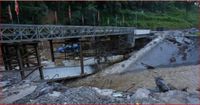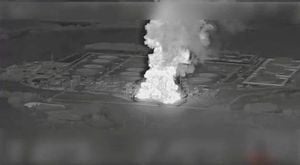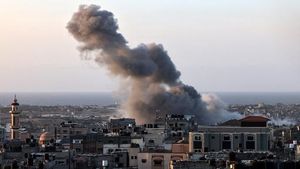Ten days after the Myanmar military government recaptured the strategic town of Kyaukme in Shan State, a heavy silence hangs over its battered streets. Once a bustling hub along the vital highway connecting central Myanmar to China, Kyaukme now sits as a stark symbol of the country’s ongoing civil war, its fate shaped by relentless battles and shifting control between the military and ethnic militias.
According to the Associated Press, schools have reopened—at least on paper—but the town’s market is a shadow of its former self. Vendors, wary and visibly nervous, closed their stalls at the sight of visiting journalists. The AP’s rare visit, tightly supervised by the military and pro-government media, offered a glimpse into a town where daily life has been upended and fear lingers in the air.
The scars of recent conflict are everywhere. Charred remains of official buildings—courthouse, police station, government housing—dot the landscape. Much of the area around the town’s hospital has been reduced to rubble, forcing medical operations to shift temporarily to a nearby Chinese temple. At least one fire engine lies burnt out, a silent testament to the intensity of recent clashes. Despite this devastation, civilian houses appear largely untouched, except for those near the destroyed official structures. Still, the damage has driven the majority of Kyaukme’s original population of 46,000 to flee, leaving behind deserted neighborhoods and empty streets.
The story of Kyaukme’s turmoil is intimately tied to its location. Perched about 115 kilometers (70 miles) northeast of Mandalay, the nation’s second-largest city, Kyaukme sits at a key junction on the trading route to China. This geography has made it a prize for both sides in Myanmar’s brutal civil war. As reported by the Associated Press, the town has changed hands twice since the military ousted Aung San Suu Kyi’s elected government in 2021, sparking widespread resistance from ethnic militias and pro-democracy groups.
In August 2024, the Ta’ang National Liberation Army (TNLA), a militia representing the Palaung ethnic minority, seized control of Kyaukme amid a surge of victories by anti-military forces. Their grip on the town, however, proved temporary. After a fierce three-week battle, the military government retook Kyaukme on October 1, 2025—a significant victory as it tries to reassert control over contested regions ahead of elections scheduled for the end of the year.
The military’s recent offensives have been relentless. Before turning their sights on Kyaukme, government forces recaptured the nearby town of Nawnghkio in July 2025. Nawnghkio is seen as a gateway to Myanmar’s heartland, sitting at the crossroads of the country’s eastern hills and central flatlands. The road from Nawnghkio to Kyaukme, a stretch of 55 kilometers (33 miles), is lined with bombed-out buildings, debris, and army checkpoints manned by newly drafted soldiers every 500 to 1,000 meters. Even a major bridge along the route, though damaged, remains standing and is currently under repair.
Journalists’ access to Kyaukme remains tightly controlled. Authorities blocked entry to certain residential areas, citing the danger of uncleared land mines. As Capt. Wai Yan Kyaw, stationed at one of the town’s gates, told the Associated Press, “There are still land mines that haven’t been cleared in parts of the neighborhood.” The AP team witnessed unexploded ordnance, including a mortar shell embedded in the ground at a Buddhist monastery. The ever-present threat of hidden explosives is just one more reason why most residents have not returned.
Those who have stayed behind live in a state of constant anxiety. “People are unwilling to live near the front line,” a motorbike taxi driver in his mid-30s shared with the AP, asking not to be named for his own safety. He described the streets as “virtually deserted” and doubted that residents would come back until the military secured more nearby towns. Another local, who also spoke anonymously, said the overwhelming majority fled after fighting broke out last year. Only those who could not afford to leave remained, enduring the dangers and uncertainty of life in a war zone.
The TNLA, which controlled Kyaukme for over a year, has accused the army of causing much of the destruction through air strikes and heavy weapons. Conversely, government soldiers claim that retreating militia forces destroyed key infrastructure as they withdrew. With both sides blaming each other for the devastation, the town’s civilian population is left to pick up the pieces—if they ever return at all.
Kyaukme’s strategic importance means it is unlikely to see peace soon. According to soldiers stationed in the area, TNLA forces are believed to be just 32 kilometers (20 miles) away in the surrounding hills, keeping the front line perilously close. The military’s push to recapture contested towns like Kyaukme is widely seen as an effort to bolster legitimacy ahead of the upcoming elections. However, critics argue that the polls will be neither free nor fair, given the ongoing conflict and the government’s tight control over information and movement. The Associated Press notes that the military hopes a high turnout will help legitimize the vote, but with most of Kyaukme’s residents still displaced, such hopes may be misplaced.
Amid this turmoil, ordinary citizens are left to navigate a landscape transformed by war. The once-busy market is now a symbol of absence, its stalls shuttered and its vendors fearful. Schools have reopened, but with few students in attendance, education remains a distant hope for many families. The hospital, relocated to a temple, serves as a reminder of both resilience and loss. And the ever-present risk of land mines and unexploded ordnance keeps the threat of violence alive, even in moments of uneasy calm.
The story of Kyaukme is, in many ways, the story of Myanmar itself: a nation caught between competing forces, its people bearing the brunt of a conflict with no clear end in sight. As the military government pushes forward with its campaign to retake territory and prepare for elections, the fate of towns like Kyaukme hangs in the balance—caught between hope for stability and the harsh realities of war.
For now, Kyaukme remains a town in limbo. Its streets, once filled with life, are now marked by silence and uncertainty. Whether its residents will return, and whether peace will ever take hold, remains to be seen. But the scars of this conflict—visible in every burned building and empty home—will not soon be forgotten.




